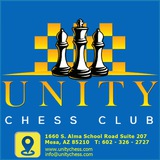A rare case where the knight is stronger than the bishop in an open position. Why is this? Firstly, the knight is entrenched on an outpost deep in White’s camp, whereas the bishop is unstably placed, and secondly, Black’s major pieces are much more active.
More tenacious was 24.Kh1, although with the move 24...h6!, Black ensures himself the square g5 for his rook. Incidentally, b3 hangs.
Unity Chess Club
German Fridstein Vladimir Simagin Moscow 1950 Black to move
The black knights occupy stable positions, thanks to which his position is clearly better. But how can he strengthen it? If he transfers the knight from h5 to e6, White gets counterplay by advancing his h-pawn. The advance of the queenside pawns also fails to achieve the desired effect: 28...b5 29.Ra1 Qb6 30.Rhb1, and the passed pawns are stopped.
The pawn on f4 is a clear weakness, but increasing the pressure on it is only possible by exploiting the full scope of the board:
The pawn on f4 is a clear weakness, but increasing the pressure on it is only possible by exploiting the full scope of the board:
There is no defence against ...Qd8-h4, with a complete collapse of the white kingside. There followed:
Unity Chess Club
Training position Konstantin Sakaev White to move
Structurally, Black is doing poorly, as his Na5 is out of play and his light squares weak. His main hope is the d-pawn, which can advance to d3. However, it is White’s move, and he has a way to exert additional pressure on e6, with the help of the hard-to-spot retreat...
The white pieces develop decisive activity, since there is no defence to the double capture on e6, followed by the rook’s entry to c7.
Unity Chess Club
Vitezslav Rasik 2466 Stellan Brynell 2511 Rethymnon tt 2003 Black to move
At first sight, Black is in trouble, because 27.Rxc8 is a threat and the bishop cannot escape this attack. But Black has a surprising way to activate:
